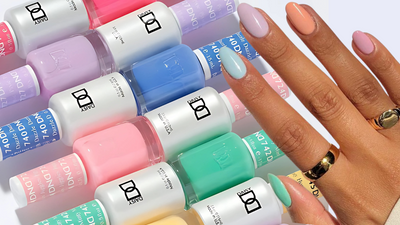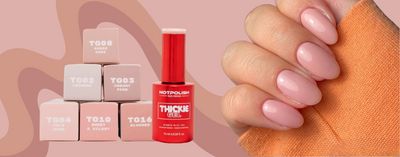
Does anyone remember the day when your only choices for a manicure were smelly and smudgy traditional polished or acrylic nails? Thankfully, two new options have emerged and are growing in popularity: gel and powder dip manicures. Both types don’t harm your nails, are long-lasting, and come in an expansive range of colors. But which is better for your nails—powder dip or gel? We’ll go through the qualities of each so that you can decide which option is best for you.
Powder Dip Manicures
Understanding the difference between powder dips and gels is the first step to looking at powder dip vs. gel and determining which is better for your nails.
Let’s start with powder dips.
You can do a powder dip manicure by applying a base coat, dipping the nail in powder, applying an activator, and sealing the nail with a topcoat. We love OPI nail dip powders, as they have a myriad of benefits. For one, they last much longer than gel manicures. They are odor-free, come in a swath of gorgeous colors, and won’t chip for up to one month.
No Damaging UV Light
Powder dip manicures do not require harmful UV light to dry, unlike gel manicures. This means you won’t have to invest in any extra equipment to do your own powder dip manicure at home. Moreover, you don’t have to worry about encountering any damaging UV rays. Even though UV doesn’t penetrate the nail, it can cause damage to the top of your hand over time, though. So keep that in mind.
Gel Manicures
Now, we move on to gel manicures and how they differ from powder dip manicures. There are several advantages of these as well.
Healthy Longevity vs. Extreme Longevity
Gel manicures last a long time, but not an excessively long time. While powder dip manicures last up to a few weeks longer than gel manicures, this longevity could do more harm than good. For example, you could have a serious issue going on underneath a nail, and you wouldn’t know that issue existed for quite a long time.
No Risk of Bacterial Infection
Not all powder dip manicures are hygienic. Whether you’re in a salon or at home, if you don’t thoroughly wash your hands and trim off dead skin cells, you could transmit bacteria into the powder. Additionally, the act of pushing down your cuticles could cause a certain type of inflammation called initis or trigger an infection.
While avoiding pushing down your cuticles is something that could go for both gel and powder dip manicures, powder dips potentially contribute to damage or infection through the base coat itself. Occasionally, companies make these base coats with monomers, which are known allergens. Monomers can cause uncomfortable and painful symptoms such as redness, swelling, and even blistering. In worst-case scenarios, they can cause the nail to separate from the nail bed completely. These are issues that do not present themselves with gel manicures.
If you want to get a powder dip manicure, you can do a few things to avoid these concerns. First and foremost, deny yourself the luxury of a powder dip if you are allergic to monomers. The pain and potential damage are just not worth it. If you’re not allergic to monomers, avoid infection by using your own powder dip or brushing the powder onto the nail rather than dipping your nail into the container. If the salon you’re at doesn’t offer individual dip containers, don’t get a powder dip manicure.
Some may argue that the brushes for gel polishes also transmit infections. But the truth is that microbes do not survive in them.
Gentler Removal Process
While it’s not necessarily a disaster to remove powder dip manicures (if for some odd reason you must do so), you’ll have an easier time removing gels. The reason is that powder dips don’t come off easily with traditional nail polish remover. Rather than coming off, the topcoat just becomes duller.
To remove a powder dip manicure, you often have to use e-files first to file the thickness down. Then, you must soak your nails in acetone. Doing this for short periods (like you would for gel manicures) is fine, but you start running into trouble when you soak your nails for long periods. The acetone can cause your nail to thin and can really irritate the skin around your nail.
Whether you get a gel or powder dip manicure, the removal process requires acetone. Since any amount of acetone dehydrates your nails, you’ll notice that your nails are brittle and more prone to breaking. It’s up to you whether you want shorter or longer acetone exposure.
We get it—that last bit of advice sounds pretty discouraging, especially since there’s not much you can do about it. The good news is that you can help your nails heal after an acetone soak. Invest in a quality cuticle oil and apply it nightly before you go to bed. Your nails will absorb the vitamins and moisture, which will help them to rehydrate and strengthen. If you don’t have cuticle oil, you can also use petroleum jelly.
Fewer Health Risks Overall
Even though powder dip manicures aren’t dangerously harmful to your health (unless you’re allergic to the base coat), they do pose more health hazards than gel manicures. These hazards include:
- The need to use an electric file to remove the powder dip coats before applying acetone for removal, which thins and further weakens nails
- The possibility of infection from sharing powders
- The possibility of allergic reactions from the monomers in the base coat
It’s important to note, though, that some people don’t have any adverse reactions to powder dip manicures at all. The basecoat, filing, and acetone don’t bother their nails. If your nails don’t react negatively to the powder dip process or any of the techniques or products used in it, there’s no reason to stop getting powder dip manicures! However, if you see nail damage, try to cut back on powder dips and go for gel manicures.




